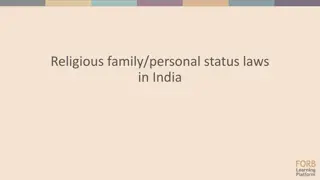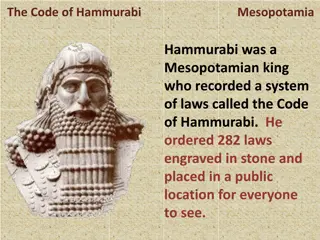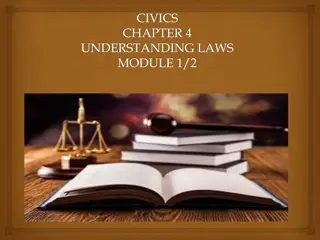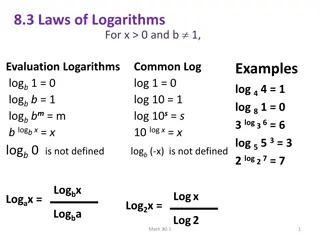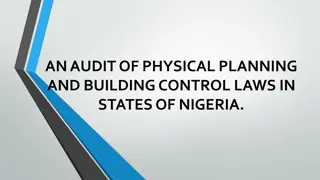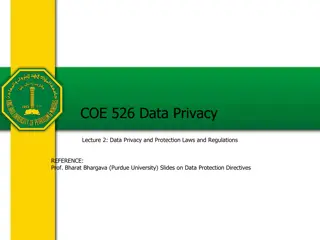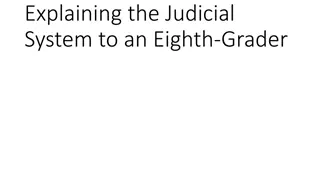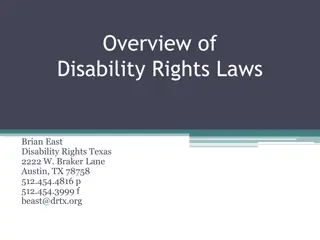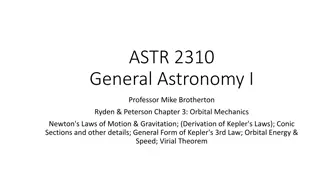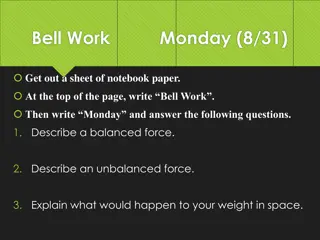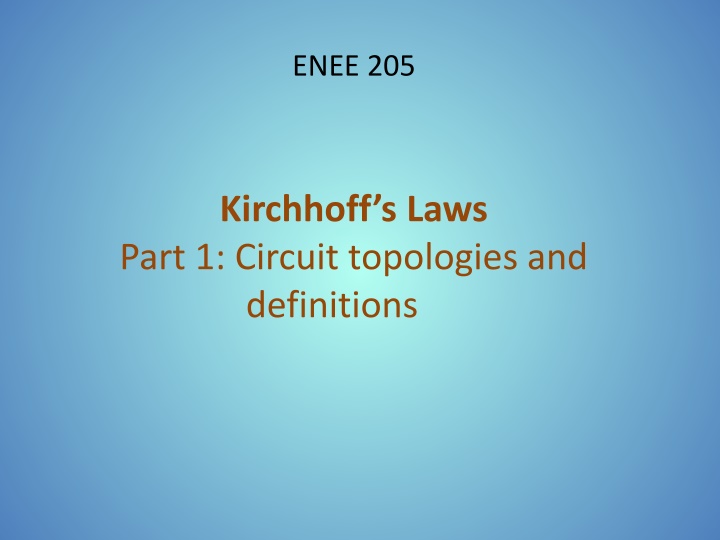
Circuit Topologies and Kirchhoff's Laws
Explore circuit topologies, nodes, branches, and meshes in Kirchhoff's laws. Learn about Kirchhoff's Current Law (KCL) and Voltage Law (KVL) for circuit analysis. Discover the relationship between nodes, branches, and meshes in electrical circuits.
Uploaded on | 4 Views
Download Presentation

Please find below an Image/Link to download the presentation.
The content on the website is provided AS IS for your information and personal use only. It may not be sold, licensed, or shared on other websites without obtaining consent from the author. If you encounter any issues during the download, it is possible that the publisher has removed the file from their server.
You are allowed to download the files provided on this website for personal or commercial use, subject to the condition that they are used lawfully. All files are the property of their respective owners.
The content on the website is provided AS IS for your information and personal use only. It may not be sold, licensed, or shared on other websites without obtaining consent from the author.
E N D
Presentation Transcript
ENEE 205 Kirchhoff s Laws Part 1: Circuit topologies and definitions
Circuit topologies/definitions - NODES Nodes points where two or more component terminals are connected together or the collection of wires that connect two or more component terminals together . We denote the number of nodes in a circuit as N. Trivial node a node which connects exactly two components. Non-trivial node a node with more than two connected components For the circuit to the right, there are 5 nodes : Nodes A Node E Trivial nodes (2): Nodes A, C Non-trivial nodes (3): B (3 connections), D (3 connections), and E (4 connections), Note: reference are currents shown in the figure. 6 F Node E i6 sin(4t) A Node D 2 Ohms i2 Node A i3 i5 i1 + v4 - cos(2t) V 3 H 5 H 7 F i7 Node B Node C
Circuit topologies/definitions - MESHES Loops closed paths in a circuit, or, the list of components encountered when one moves along a closed path (path must not pass through a point more than once). Mesh a loop that does not completely enclose any components. We denote the number of meshes in a circuit as M. Trivial mesh a mesh which contains exactly two components. Non-trivial mesh a mesh that contains more than two components. 6 F 3 For the circuit to the right, there are 3 meshes Trivial meshes (1): mesh 3 Non-trivial meshes (2): mesh 1 (3 components), and mesh 2 (4 components) i6 sin(4t) A 2 Ohms i2 i3 i5 i1 + v4 - 1 5 H 3 H 2 cos(2t) V 7 F i7
Circuit topologies/definitions - Branches Branch a general term for any two-terminal component, whether active or passive, We denote the number of branches in a circuit as B. It turns out that the there is a relationship between B, N, and M: B = M + N -1 Because of this equation, meshes are more useful than loops we will determine Kirchhoff s Equations on meshes and nodes, but not generally on loops that are not meshes. For the example to the right, there are 5 nodes , 3 meshes, and 7 branches However, there are 6 loops! 6 F i6 sin(4t) A 2 Ohms i2 i3 i5 i1 + v4 - 5 H 3 H cos(2t) V 7 F i7
ENEE 205 Kirchhoff s laws Part 2: Kirchhoff s Current Law (KCL) and Kirchhoff s Voltage Law (KVL)
KIRCHHOFFS CURRENT LAW (KCL) Kirchhoff s laws come from laws of physics. PHYSICAL LAW: NET CHARGE CAN NOT BE CREATED OR DESTROYED Consequence: If the net charge in some volume is increasing or decreasing, current must be entering or leaving that volume, respectively. Consequence: If there is no net change in charge in a volume, the sum of all currents entering and leaving the volume must be zero. In circuit theory, our volumes are ones that contain nodes, and nodes have no net charge, so we get Kirchhoff s Current Law (KCL): The algebraic sum of currents entering a node equals zero.
KCL - continued Algebraic means that if a current is entering a node, we put a plus sign in front of the reference current in KCL for that node. However, if a reference current is pointed away from a node, we place a minus sign in front of the reference current. Note: One can write N KCL equations for any circuit, but only N-1 equations are linearly independent. Note: remember that the reference current does not indicate the direction of current, it only tells us how to interpret a positive or negative current: A positive value indicates that the actual current IS in the direction of the reference current, while a negative result tells us that the actual current is flowing in the opposite direction.
KCL examples i1 i4 i3 For the single node on the left: ?1 ?2 ?3+ ?4=0 6 F i2 Node E For the circuit on the right: Node A: ?1 ?2 = 0 Node B: ?1+ ?3+ ?7 = 0 Node C: ?5+ ?7 = 0 Node D: sin(4?) ?5 + ?6 = 0 Node E: ?2 ?3 ?6 sin(4?) = 0 Notice that if you sum the first four equations, you get the fifth equation (times -1), so the 5th is linearly dependent on the other equations. i6 sin(4t) A 2 Ohms i2 Node D Node A i3 i5 i1 + v4 - 5 H 3 H cos(2t) V 7 F i7 Node B Node C
KIRCHHOFFS VOLTAGE LAW (KVL) PHYSICAL LAW: A (QUASI-) STATIC ELECTRIC FIELD IS A CONSERVATIVE FIELD Consequence: The voltage difference from point A to point B does not depend on the path. Consequence: The net voltage change around a closed path equals zero. In circuit theory, our paths are around loops and meshes, so we get Kirchhoff s Voltage Law (KVL): The algebraic sum of voltage drops around a mesh or loop equals zero.
KVL, continued Algebraic means that if , while traversing a loop, one enters a positive terminal (for a reference voltage) and then leaves the negative terminal, that constitutes a voltage drop and that reference voltage is written in KVL with a plus sign. Otherwise, it is a voltage rise, and the reference voltage is written in the KVL equation with a minus sign. Notes: We always traverse the meshes in a clockwise manner. There are only M linearly independent KVL equations, so we normally only write them for meshes.
KVL examples For the single mesh on the left: ?1+?2 ?3 ?4 ?5 ?6+ ?7 ?8 = 0 IV + v6 - For the three meshes in the circuit on the right: 1 cos 2? + ?2+ ?3= 0 (2) ?3+ ?4+ ?5 ?7= 0 (3) ?4+ ?6= 0 For the loop (IV) all the way around the exterior of the circuit: cos 2? + ?2+ ?5+ ?6 ?7= 0 Which is the sum of the three mesh KVLs and as such is linearly dependent. 6 F 3 + v2 - i6 sin(4t) A 2 Ohms i2 + V5 i3 i5 + i1 + v4 - 1 V3 5 H 3 H 2 cos(2t) V 7 F - i7 - + v7 -
ENEE 205 Kirchhoff s laws Part 3: The complete set of first- order differential equations needed to find all voltages and currents in a circuit
Unique circuit solutions It can be shown (but we won t) that we can always generate the number of equations that we need to uniquely solve any circuit problem for all voltage and currents for all components. When the circuit only has two-terminal components (i.e. no op- amps), if there are B branches (components), we need 2B equations. Terminal relationships, plus expressions for dependent and independent sources, give us half of those equations. The other half come from N-1 KCLs and M KVLs. For circuits with op-amps, we need to use the three consequences of the ideal op-amp assumptions, plus terminal relationships, KCLs and KVLs to come up with the required number of equations to solve uniquely for all voltages and currents in the op-amp circuit.
ALGORITHM TO FIND THE COMPLETE SET OF 1ST ORDER DIFFERENTIAL EQUATIONS (WITH NO OP-AMPS): Step 0 Obtain circuit Step 1 Label nodes and meshes (Find B, N, M) Step 2 Assign reference directions Step 3 Write B KLs Step 3a Write N-1 KCLs Step 3b Write M KVLs Step 4 Write one Terminal Relationship (TR) for each passive component - plus one equation for each dependent source Step 5 Plug TRs into KLs Step 6 Write one (symbolic) Initial Condition (IC) for each energy storage element Step 7 Box Answer!
Step 0 Obtain circuit Here is a simple transistor circuit: Here is the model of the simple transistor circuit with a current- controlled current source:
Step 1 Label nodes and meshes (Find B, N, M) C B = 11 N = 6 M = 6 III II D B A V I E VI IV F
Step 2 Assign reference directions C - - i5 V4 V3 III II + + + i4 i3 V5 - D i2= i7 i11 B A + - + V11 - + V7 - i1 V V2 i6 V8 - i8 i7 + V1 - + I + V9 - E i9 - VI - V6 V10 + IV + i10 F
Step 3a Write N-1 KCLs A: ?1 ?11 = 0 B: ?3+ ?6 ?7+ ?11 = 0 C: ?3+ ?4+ ?5 = 0 D: ?2 ?4+ ?8 = 0 F: ?1 ?5 ?6+ ?9 ?10 = 0 E has five components connected, so we choose to omit that node. C - - i5 V4 V3 III II + + + i4 i3 V5 - D i2= i7 i11 B A + - + V11 - + V7 - i1 V i6 V2 V8 - i8 i7 + V1 - + I + V9 - E i9 - VI - V6 IV V10 + + i10 F
Step 3b Write M KVLs I: ?1 ?6+?11 = 0 II: ?2+?3 ?4 ?7 = 0 III: ?4+ ?5+ ?8 ?9 = 0 IV: ?9+?10 = 0 V: ?2 ?8= 0 VI: ?6+ ?7 ?10= 0 C - - i5 V4 V3 III II + + + i4 i3 V5 - D i2= i7 i11 B A + - + V11 - + V7 - i1 V i6 V2 V8 - i8 i7 + V1 - + I + V9 - E i9 - VI - V6 IV V10 + + i10 F
Step 4 Terminal Relationships: Write one Terminal Relationship (TR) for each passive component: ?3= ?3?3 ?6= ?6?6 ?7= ?7?7 ?8= ?8?8 ?9= ?9?9 ?4= ?4??4/?? ?10= ?10??10/?? ?11= ?11??11/?? List dependent source dependencies: i2= i7 C - - R3 L4 i5 V4 V3 III II + + C11 + i4 i3 V5 - D i2= i7 i11 B A R7 R8 + + V11 - + V7 - - V8 i1 V i6 V2 - + i8 i7 + V1 - I + V9 - E i9 - VI R9 - V6 IV V10 + R6 C10 + i10 F
Step 5 Plug TRs into KLs KCLs: A: ?1 ?11 = 0 B: ?3+ ?6 ?7+ ?11 = 0 C: ?3+ ?4+ ?5 = 0 D: ?2 ?4+ ?8 = 0 F: ?1 ?5 ?6+ ?9 ?10 = 0 KCLs: A: ?1 ?11??11/??= 0 B: ?3+ ?6 ?7+ ?11??11/??= 0 C: ?3+ ?4+ ?5 = 0 D: ?7 ?4+ ?8 = 0 F: ?1 ?5 ?6+ ?9 ?10??10/??= 0 KVLs: I: ?1 ?6+?11 = 0 II: ?2 + ?3 ?4 ?7 = 0 III: ?4+ ?5+ ?8 ?9 = 0 IV: ?9+?10 = 0 V: ?2 ?8= 0 VI: ?6+ ?7 ?10= 0 KVLs: I: ?1 ?6?6+?11 = 0 II: ?2 + ?3?3 ?4??4/?? ?7?7= 0 III:?4??4/?? + ?5+ ?8?8 ?9?9= 0 IV:?9?9+ ?10 = 0 V: ?2 ?8?8= 0 VI:?6?6+ ?7?7 ?10= 0
Step 6 List all initial conditions Write one (symbolic) Initial Condition (IC) for each energy storage element. Voltage continuity equations for capacitors: ?10(?0 )= ?10(?0+) ?11(?0 )= ?11(?0+) Current continuity equations for inductors: ?4(?0 )= ?4(?0+)
Step 7: Box your answer KCLs: A: ?1 ?11??11/??= 0 B: ?3+ ?6 ?7+ ?11??11/??= 0 C: ?3+ ?4+ ?5 = 0 D: ?7 ?4+ ?8 = 0 F: ?1 ?5 ?6+ ?9 ?10??10/??= 0 KVLs: I: ?1 ?6?6+?11 = 0 II: ?2 + ?3?3 ?4??4/?? ?7?7= 0 III:?4??4/?? + ?5+ ?8?8 ?9?9= 0 IV:?9?9+ ?10 = 0 V: ?2 ?8?8= 0 VI:?6?6+ ?7?7 ?10= 0 Initial Conditions: Capacitor voltages: ?10(?0 )= ?10(?0+) ?11(?0 )= ?11?0+ Inductor current: ?4(?0 )= ?4(?0+)
Solution techniques Note that our algorithm gives B equations that need to be solved simultaneously. If B is a large number (11 in the last example), that can be a difficult task. If there are trivial nodes or meshes, we can reduce the number of equations we need to solve simultaneously. Two components connected by a trivial node are said to be in series and they always have the same current through them, so we can eliminate one equation for each trivial node. Two components connected in a trivial mesh are said to be in parallel and they always have the same voltage across them, so we can eliminate one equation for each trivial mesh. If the circuit contains only sources and resistors, the equations will be algebraic (no derivatives), and we can write the equations in matrix form, and then solve the matrix equation using software like MATLAB, or techniques like Kramer s rule, Gaussian elimination or direct matrix inversion (e.g. for 2x2 matrices)
ENEE 205 Kirchhoff s laws: Part 4: Examples with DC sources
EXAMPLE DIRECT CURRENT (DC) CIRCUITS We will see later in the course that if a circuit has only batteries as sources (or constant (DC) current sources), some time after the circuit is assembled, the inductors will act like short circuits (simple wires) and capacitors will act like open circuits (no connection). So all that is left are batteries and resistors. There may be other components (like diodes or motors), but those other components will act like resistors or will draw a constant current or require a constant voltage (and thus act like sources). In the next few slides we will solve a few of these DC circuits
A Simple LED circuit Node A iR iD=30 mA + VR - Consider the circuit shown to the right. We want to light the LED properly. The data sheet says that a blue LED needs 30 mA to be bright and the voltage drop is 3.3 V + I 3.3V - The design requires only selecting the proper value of the resistance. The circuit is simple enough that we don t need to follow the algorithm. KVL for mesh I: -5 V + VR + 3.3 V = 0 or VR = 1.7 V KCL for Node A: iR iD = 0 or iR = iD = 30 mA Ohm s Law: R = VR/iR = 1.7 V / 30 mA = 56.67 Standard resistances are 56 and 62 So pick one of those for your circuit. (There is a precision 56.7 resistor, but that is not necessary and they are much more expensive!)
Charging a Battery Consider the circuit shown to the right. It could be used as a simple battery charger. (The 5V source will charge the V1 battery.) Let s say that V1 is normally a 3.3V battery when fully charged. When discharged, the voltage is typically less than 1 V. We need to design the circuit (i.e. find the value of resistance R) so that the battery charges until it reaches 3.3V. That means that the current going into V1 must go to zero Let s use the general algorithm to find the complete set of algebraic equations, and then we ll simplify and solve.
Step 1 Label nodes and meshes (Find B, N, M) B = 4 N = 3 M = 2 A B I II C
Step 2 Assign reference directions A i3 B i2 - V3 + + i4 i1 V2 I II - C
Step 3a Write two KCLs A: ?1 ?2+?3 = 0 B: ?3+ ?4 = 0 A i3 B i2 - V3 + + i4 i1 V2 I II - C
Step 3b Write two KVLs I: ?1+?2 = 0 II: ?2 ?3+ 5? = 0 A i3 B i2 - V3 + + i4 i1 V2 I II - C
Step 4 Terminal Relationships: ?2= ??2 ?3= 1000?3 A i3 B i2 - V3 + + i4 i1 V2 I II - C
Step 5 Plug TRs into KLs KCLs: A: ?1 ?2+?3 = 0 B: ?3+ ?4 = 0 KVLs: I: ?1+??2 = 0 II: ??2 1000?3+5? = 0 A i3 B i2 - V3 + + i4 i1 V2 I II - C
Step 6 List all initial conditions There are no inductors or capacitors, so there are no initial conditions needed )or available). Step 7: Box your answer KCLs: A: ?1 ?2+?3 = 0 B: ?4 = ?3 KVLs: I: ?1+??2 = 0 II: ??2+1000?3= 5? Note: i1 i4 are the unknowns v1 and R are to be given.
Simplify and solve Here are the equations: A: ?1 ?2+?3 = 0 B: ?4 = ?3 We can ignore this trivial node equation KVLs: I: ?1+??2 = 0 We can re-write as ?1/? = ?2 II: ??2+1000?3= 5? Plugging (I) into (II): 1000?3= 5? ?1 or (III) ?3= (5? ?1)/1000 Plugging (III) and (I) into (A) gives: ?1= (5? ?1)/1000 ?1/? We want ?1to be zero when ?1=3.3V, so 0 = 1.7?/1000 3.3?/? or ? = 1000(3.3?/1.7?) = 1941 = 1.941 k
ENEE 205 Kirchhoff s laws Part 5: Circuits with op-amps
SOLVING CIRCUITS WITH OP-AMPS We could come up with an algorithm for finding the complete set of equations needed to solve for all voltages and current in a circuit with op-amps. It would involve much of the past algorithm, plus using the consequences of the three ideal op-amp assumptions. However, for most op-amp circuits, the goal will be to find a single equation for the output voltage in terms of the input voltage(s). Thus, an algorithm that accomplishes that goal typically requires only two KVL equations and one or two KCL equations, plus terminal relations and ideal op-amp consequences. Three op-amp circuits are analyzed in the following slides.
INVERTING AMPLIFIER KVLs: I: ???+ ?????? ?? = 0 II: ??+????+ ???? = 0 Since ?? = 0 (ideal op-amp) ???= ???/??? ??= ????/?? + RinIin - + RfIf - Iin If Rin Rf KCL: A: ??? ?? ? = 0 Since ? = 0 (ideal op-amp) ???= ?? Node A II I- - vd I Vin + Vout - + I+ Combining Equations: ???/???= ???= ??= ????/?? or ????= (??/ ???)???
DIFFERENTIATING (INVERTING) AMPLIFIER KVLs: I: ???+ ?? ?? = 0 II: ??+????+ ???? = 0 Since ?? = 0 (ideal op-amp) ??= ??? ??= ????/?? KCL: A: ??? ?? ? = 0 Since ? = 0 (ideal op-amp) ???= ?? We need the terminal relation: ??? ??= ??? or ????= ????? + RfIf - + Vc - Iin If Cin Rf Node A II I- - vd I Vin + Vout - + I+ ???? ?? ???= ??? = ????/?? ???? ??
NON-INVERTING AMPLIFIER KVLs: I: ?????? ??+??? = 0 II: ???+ ??+????+ ???? = 0 Since ?? = 0 (ideal op-amp) ???= ???/??? ??= (??? ????)/?? + RinIin - + RfIf - Iin If Rin Rf Node A II I- - vd I + Vout - KCL: A: ??? ?? ? = 0 Since ? = 0 (ideal op-amp) ???= ?? + I+ Vin Combining Equations: ??? ??? or ????= (1 + ??/ ???)??? = ???= ??= (???? ???)/??



